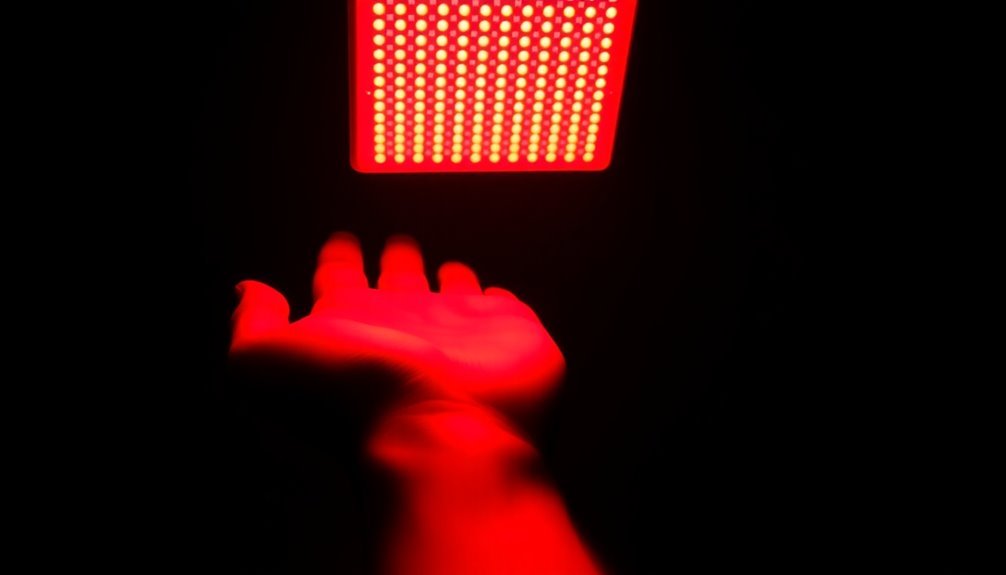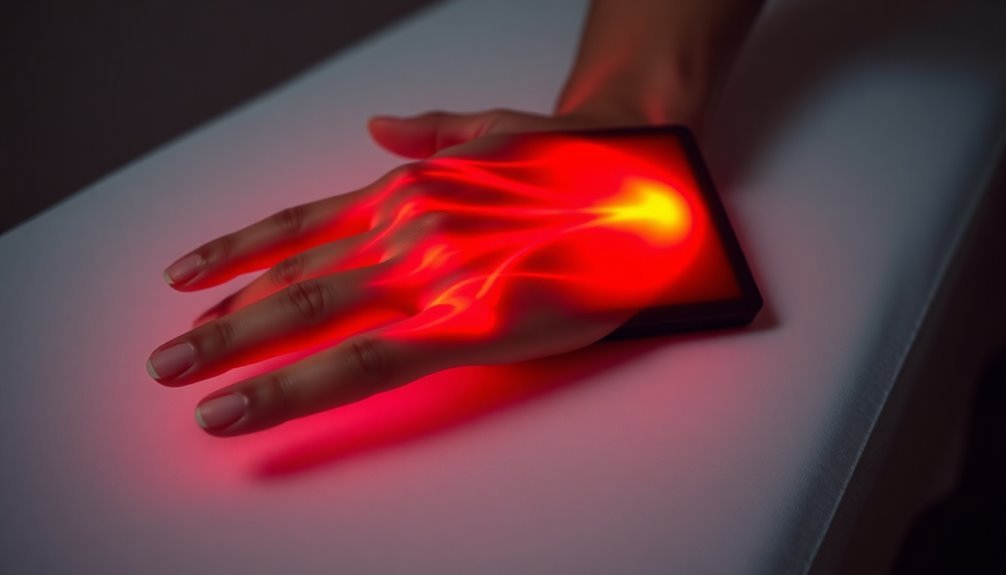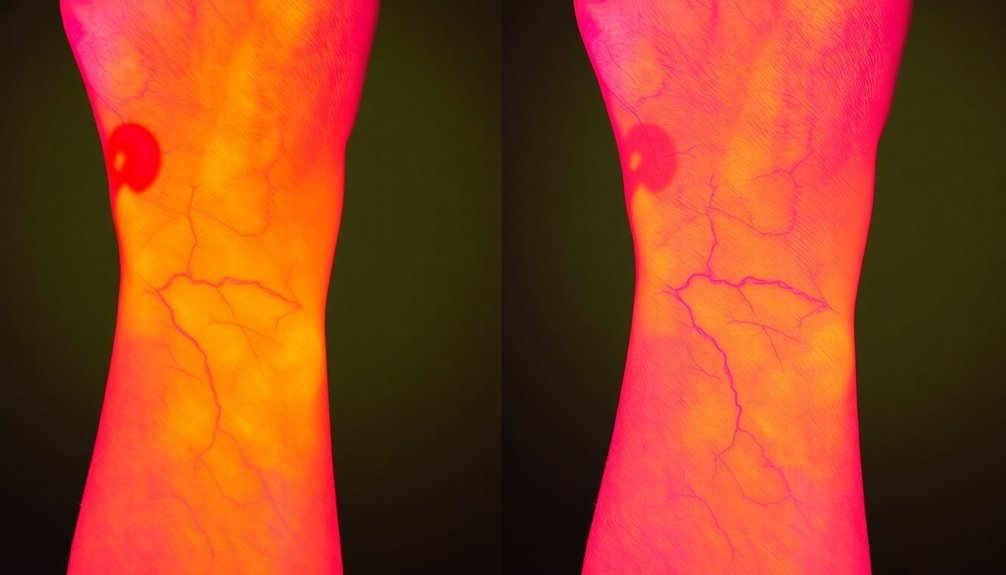Near-infrared light therapy can provide significant relief for your wrist pain by penetrating deep into your joints and tissues. It works by stimulating your cells’ natural energy production and increasing blood flow to the affected area. You’ll benefit from reduced inflammation, faster healing, and natural pain relief without medication. The therapy proves effective for various wrist conditions like carpal tunnel syndrome, arthritis, and tendonitis. Most people experience relief within 15-20 minute sessions, which you can safely do 1-3 times daily at home. Understanding the science behind this breakthrough treatment reveals even more impressive benefits for your recovery.
Understanding Near-Infrared Light Benefits

Near-infrared light therapy consistently proves to be a powerful tool for pain management and healing. When you’re dealing with wrist pain, you’ll find that this therapy penetrates deep into your tissues, reaching muscles, tendons, and bones.
It works by stimulating your cells to produce more ATP, which is essential for healing and pain relief. The electron transport chain becomes more efficient during this process, maximizing cellular energy production.
You’ll experience several key benefits when using near-infrared light therapy. It triggers the release of endorphins, your body’s natural painkillers, while simultaneously improving blood flow to the affected area. As circulation increases, oxygen and nutrients reach your injured tissues more effectively, speeding up the healing process.
The therapy’s most impressive feature is its ability to reduce inflammation without medication. It’s particularly effective for conditions like carpal tunnel syndrome, where you need deep tissue penetration to address the underlying issue.
Operating at wavelengths between 800-880nm, with 850nm being the most effective, the light reaches deeper structures than other therapeutic options. When combined with red and amber light, you’ll get even better results.
The best part? It’s completely non-invasive and painless, with no known side effects, making it a safe choice for ongoing pain management.
Common Wrist Pain Causes
While many people focus solely on treatment options, understanding the root causes of wrist pain is essential for effective management. Your wrist pain likely falls into one of several common categories that affect millions of people worldwide.
| Pain Type | Common Causes | Key Symptoms |
|---|---|---|
| Repetitive Strain | Typing, writing, sports | Gradual onset, stiffness |
| Acute Injury | Falls, impacts, sports | Sudden pain, swelling |
| Inflammatory | Arthritis, tendonitis | Chronic pain, redness |
If you’re experiencing wrist discomfort, it’s likely due to repetitive motions or physical strain. Activities like typing, using tools, or participating in sports can lead to overuse injuries and chronic pain. Sudden impacts or falls can cause immediate injuries, resulting in fractures, sprains, or strains.
Inflammatory conditions like arthritis and tendonitis also commonly trigger wrist pain. You might notice symptoms such as swelling, stiffness, and reduced mobility. Poor posture during these activities can significantly worsen your wrist problems and lead to additional complications. Other factors, including ganglion cysts and carpal tunnel syndrome, can compress nerves and cause persistent discomfort. Age and certain health conditions may increase your susceptibility to wrist problems, making it vital to identify and address these underlying causes.
How Near-Infrared Targets Joint Pain

When treating wrist pain, understanding how near-infrared therapy works can substantially boost your chances of relief. This treatment targets joint pain through multiple mechanisms that work together to reduce your discomfort and promote healing.
Near-infrared light penetrates deep into your wrist tissues, triggering a photobiological response that reduces inflammation. It specifically decreases inflammatory markers like IL-1β and IL-6, which are often responsible for joint pain. Women may particularly benefit from this therapy, as women account for 60% of individuals affected by joint conditions like osteoarthritis.
You’ll benefit from improved blood circulation as the therapy stimulates cellular energy production in the affected area.
What makes near-infrared therapy particularly effective is its ability to prompt your body’s natural pain-fighting responses. It stimulates the release of endorphins – your body’s natural painkillers – while activating endogenous opioid receptors. You’ll experience pain relief as the therapy works on both superficial and deeper tissues of your wrist.
The treatment’s dual action of photothermal and photobiological effects enhances tissue repair by boosting collagen production and cellular energy. This thorough approach means you’re not just masking the pain – you’re addressing its underlying causes through improved circulation, reduced inflammation, and enhanced tissue healing.
Treatment Methods and Duration
You’ll need to schedule NIR therapy sessions of 15-20 minutes per treatment area, targeting your wrist pain with a combination of 880nm infrared and 660nm red light wavelengths.
For best results, you can apply the therapy 1-3 times daily, ensuring you maintain consistent intervals between sessions according to your device’s guidelines.
If your device has an auto-shutoff feature, it’ll help you stick to the recommended treatment duration while preventing overuse during each session.
A thin layer of contact oil should be applied to enhance the effectiveness of both the light penetration and cooling during treatment.
Recommended Session Protocols
Effective near-infrared light therapy for wrist pain follows specific protocols designed to maximize healing and pain relief.
You’ll need to undergo multiple sessions, typically lasting around 30 minutes each, with treatments ranging from 1 to 10 sessions depending on your condition’s severity and response to therapy.
For best results, you’ll want to guarantee your treatment delivers a fluence of 30 J/cm², using wavelengths between 800 to 2,500 nanometers. Your therapist will apply the near-infrared light directly to your wrist in 2.5-second pulses using either LED or laser devices.
The therapy works by activating cytochrome c oxidase, which enhances ATP production and promotes cellular repair in the affected area. While you might notice improvement after your first few sessions, some conditions may require ongoing treatment, especially if you’re maintaining high activity levels.
You can combine near-infrared therapy with other treatments like physical therapy and medication for enhanced results. Whether you’re dealing with chronic conditions like Kienbock’s disease, carpal tunnel syndrome, or acute injuries, the therapy can help reduce inflammation and promote healing.
The treatment’s particularly effective for bone repair and musculoskeletal pain, with minimal risk of adverse effects when using FDA-approved devices.
Optimal Treatment Schedules
The ideal schedule for near-infrared light therapy combines frequency, duration, and timing to maximize pain relief in your wrist. Studies show that you’ll likely need between 1 to 10 sessions, with many patients experiencing significant improvement within the first few treatments.
Your treatment plan will be tailored to your specific needs and response to therapy. Near-infrared therapy works by releasing nitric oxide, which promotes blood flow and accelerates tissue repair in your wrist.
The timing of your sessions can be flexible based on your availability, but you’ll want to maintain consistency for best results. Most patients notice pain reduction within hours of their first or second treatment, and the relief can last for weeks to months after completing the full course of therapy.
- You can expect each session to target your wrist with NIR wavelengths between 800-1000 nanometers, penetrating 2-7 centimeters into your tissue
- Treatment modifications will help guarantee the NIR light properly reaches curved areas of your wrist
- You’ll experience faster symptom resolution compared to traditional physiotherapy methods
- Your sessions will continue until you achieve significant pain reduction or decide to stop based on satisfactory results
No complications have been reported during treatment, making this a safe option for ongoing wrist pain management.
Clinical Research on Pain Relief
Clinical studies confirm that near-infrared light therapy can substantially reduce your wrist pain through improved circulation and cellular regeneration.
You’ll typically see results within a few treatment sessions, with research showing that both 800-1,200nm and 940nm wavelengths effectively decrease inflammation and improve mobility. Nitric oxide production during treatment helps relax arteries and optimize blood flow to the affected wrist area.
Studies, including a notable case involving a 71-year-old patient with Kienbock’s disease, demonstrate that the pain relief benefits can last for months after completing your treatment course.
Research Studies Show Results
Numerous research studies have demonstrated near-infrared therapy‘s effectiveness in reducing wrist pain and improving mobility. Research findings consistently show that near-infrared light-emitting diodes (LEDs) can substantially decrease pain and inflammation, particularly in conditions like Kienbock’s disease, which affects the wrist.
The research highlights several key benefits you’ll experience with near-infrared therapy:
- Increased production of endorphins, your body’s natural painkillers
- Enhanced blood flow to affected areas, promoting faster healing
- Improved cellular energy production for better tissue repair
- Boosted collagen production and reduced inflammation
Clinical studies have shown particularly promising results when using 940 nm NIR LEDs for wrist conditions. You’ll find that the therapy’s ability to penetrate deep tissue layers makes it especially effective for treating musculoskeletal pain. The therapy is FDA-cleared and safe when administered through proper devices.
Case studies report notable improvements in both pain reduction and mobility among patients receiving this treatment. While more double-blind studies are recommended, systematic reviews confirm infrared radiation’s potential in managing musculoskeletal pain.
The therapy’s dual action of photothermal and photobiological effects contributes to its success in pain management and tissue healing.
Treatment Duration and Effectiveness
During extensive clinical trials, researchers have pinpointed ideal treatment durations for near-infrared therapy, with sessions typically ranging from 1 to 20 minutes.
You’ll need to undergo 3 to 5 treatments per week to achieve significant pain relief, though some devices are approved for daily use. For best results, you can safely use near-infrared therapy up to three times daily, with each session lasting 15-20 minutes.
Clinical studies have shown remarkable success rates, with patients experiencing pain reduction ranging from 40% to 100%. What’s particularly encouraging is that the pain relief isn’t temporary – many patients continue to feel better for weeks or months after completing their treatment regimen.
The therapy works by stimulating nitric oxide release, which improves blood circulation in your wrist area.
Your treatment’s effectiveness will depend on the device you’re using. Higher-energy devices (60 J/cm²) and those with greater irradiance (212 mW/cm²) can deliver faster results.
You’ll want to position the device closer to your skin for shorter treatment times, but always follow your device’s specific guidelines and consult with a healthcare professional before starting treatment.
Recovery and Healing Process
Through near-infrared therapy, your wrist’s recovery and healing process can substantially accelerate. When you use near-infrared light, it penetrates deep into your wrist tissues, triggering cellular stimulation and enhanced blood circulation. This process activates your body’s natural healing mechanisms, reducing inflammation and promoting tissue repair at the cellular level.
The healing process involves multiple therapeutic actions that work together to restore your wrist’s functionality. Your cells’ cytochrome c oxidase becomes activated, leading to reduced inflammation and faster tissue regeneration.
You’ll notice these key benefits during your recovery:
- Immediate relief from musculoskeletal pain, whether it’s from arthritis or carpal tunnel syndrome
- Enhanced blood circulation that delivers essential nutrients and oxygen to damaged tissues
- Accelerated tissue repair through increased cell proliferation and maturation
- Reduced inflammation and muscle tension through specific biochemical pathway activation
As clinical evidence shows, this non-invasive approach effectively treats both acute and chronic wrist conditions. Your recovery time can decrease markedly compared to traditional methods alone, and you’ll experience lasting relief as the therapy supports your body’s natural healing processes.
Best Practices for Wrist Treatment

Managing your wrist pain effectively requires a thorough approach that combines immediate care, targeted exercises, and preventive measures. You’ll need to start with basic remedies like applying ice packs for 20 minutes every few hours and taking appropriate rest periods to reduce strain.
| Treatment Type | Recommended Actions |
|---|---|
| Immediate Care | Apply ice, rest wrist, use OTC pain relievers |
| Exercise | Perform gentle stretches, wrist rotations, flexor exercises |
| Ergonomics | Adjust workstation, use proper posture, take regular breaks |
| Prevention | Wear support brace, maintain proper form, avoid overuse |
To maximize your recovery, you’ll want to incorporate specific exercises like wrist bends and rotations to maintain flexibility while building strength. Don’t forget to make ergonomic adjustments to your workstation, including proper positioning of keyboards and mice. When you’re experiencing acute pain, wearing a splint can provide necessary support, especially during sleep hours.
If your pain persists, you might consider exploring near-infrared light therapy as a complementary treatment option. Remember to consult with a healthcare provider if your symptoms don’t improve with these self-care measures, as they can provide personalized guidance for your specific condition.
Frequently Asked Questions
Can I Use Near-Infrared Therapy While Wearing Jewelry or Metal Accessories?
You can use near-infrared therapy with jewelry, but it’s best to cover metal accessories with medical tape or cloth. While it’s generally safe, consult your healthcare provider for personalized advice about your specific situation.
Is It Safe to Use Near-Infrared Therapy During Pregnancy?
Yes, you can safely use near-infrared therapy during pregnancy. It’s non-invasive and has no known adverse effects. However, you should avoid direct application to your belly and consult your healthcare provider first.
How Often Should I Replace My Near-Infrared Device?
You’ll typically need to replace your NIR device every few years, depending on usage and quality. Watch for decreased performance, physical damage, or inconsistent operation. Replace it if it’s not working effectively anymore.
Can Children Use Near-Infrared Therapy for Wrist Injuries?
Yes, you can use near-infrared therapy for your child’s wrist injuries. While it’s safe and effective, you’ll need to consult a healthcare provider first and guarantee proper supervision during treatment sessions.
Does Health Insurance Typically Cover Near-Infrared Therapy Devices?
No, you won’t typically find insurance coverage for near-infrared therapy devices. While some devices may qualify for FSA/HSA if they’re FDA-cleared, most insurance companies and Medicare don’t cover these treatments.
In Summary
Near-infrared therapy can be your natural solution for wrist pain relief. You’ll notice reduced inflammation and improved circulation as the light penetrates deep into your joint tissues. While it’s not a cure-all, consistent treatments of 10-15 minutes daily can help manage your symptoms and support healing. Remember to combine this therapy with proper rest and medical guidance for the best results.





Leave a Reply